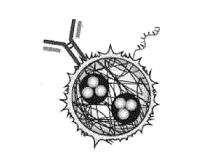BACKGROUND
Polymer microbeads are widely used in biomedical assays, diagnostics, and high-throughput screening due to their customizable surface chemistry and compatibility with suspension-based platforms. To enable multiplex detection—simultaneous identification of multiple targets within a single assay—each microbead population must be uniquely encoded or “barcoded.” Traditional barcoding methods, such as fluorescent dyes or quantum dots, face limitations including spectral overlap, photobleaching, and limited encoding capacity. These issues hinder the scalability and reliability of multiplex assays, especially when large numbers of analytes must be distinguished. There is a critical need for robust, optically distinct, and scalable barcoding technologies that can be integrated with polymer microbeads to enhance the performance of multiplex detection systems.
TECHNOLOGY
Researchers at the University of Toronto have developed a novel barcoding platform for polymer microbeads using quantum dots to enhance optical detectability and encoding capacity. Each microbead is embedded with a unique internal code—such as a pattern of quantum dots—and subsequently coated with a thin metallic nanoshell, typically gold or silver. These nanoshell-coated microbeads maintain the physical and chemical properties of standard polymer beads while offering superior optical contrast and stability. The surface of the beads can be functionalized with biomolecules, allowing for specific target binding in multiplexed assays. This approach enables the creation of large libraries of uniquely identifiable microbeads for high-throughput, multi-analyte detection.

Figure 1. The process of fabricating and functionalizing silver nanoshell-coated quantum dot microbeads. Quantum dots are loaded in the center of the polymer microbeads giving each particle a unique barcode; silver nanoparticles are used to coat the polymer surface to create the shell; the surface can be functionalization by DNA or protein for specific detection.
COMPETITIVE ADVANTAGE
- Enhanced Optical Contrast: Quantum dots significantly improve visibility under optical detection methods compared to traditional fluorescent barcodes.
- Photostability: Unlike fluorescent dyes, quantum dot barcodes do not photobleach, ensuring consistent signal over time.
- Multiplexing Capability: Unique quantum dot encoding patterns allow for high-throughput, multi-analyte detection in a single assay.
- Surface Functionalization: The barcodes can be chemically modified for specific target binding, increasing assay specificity.
- Scalability: The fabrication process is compatible with large-scale production.
APPLICATIONS
- Multiplexed diagnostic assays
INTELLECTUAL PROPERTY STATUS
- Granted US Patent
PROJECT STATUS
- Proof-of-concept studies demonstrating multiplexed detection.
KEYWORDS
metal nanoshell, barcode, multiplex detection, optical contrast, diagnostics, biosensing, gold nanoshell, encoded particles





